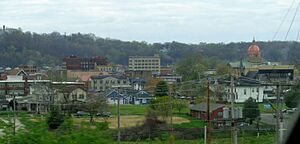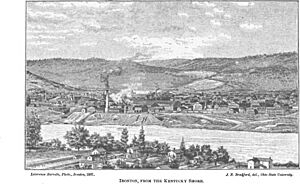Ironton, Ohio facts for kids
Quick facts for kids
Ironton, Ohio
|
|
|---|---|

Downtown Ironton looking southwest from U.S. Route 52
|
|

Location in Lawrence County and the State of Ohio
|
|
| Country | United States |
| State | Ohio |
| County | Lawrence |
| Founded | 1849 |
| Area | |
| • City | 4.75 sq mi (12.31 km2) |
| • Land | 4.47 sq mi (11.58 km2) |
| • Water | 0.28 sq mi (0.74 km2) |
| Elevation | 558 ft (170 m) |
| Population
(2020)
|
|
| • City | 10,571 |
| • Density | 2,365.41/sq mi (913.22/km2) |
| • Metro | 288,648 |
| Time zone | UTC-5 (EST) |
| • Summer (DST) | UTC-4 (EDT) |
| ZIP code |
45638
|
| Area code(s) | 740 |
| FIPS code | 39-37464 |
| GNIS feature ID | 2395438 |
| Website | ironton-ohio.com |
Ironton is a city in Ohio, located right on the Ohio River. It's the main city of Lawrence County, Ohio. In 2020, about 10,571 people lived there. Ironton is about 20 miles northwest of Huntington, West Virginia. Its name, "iron town," comes from its strong connection to the iron industry. It even had one of the first professional football teams, the Ironton Tanks.
Contents
A Look at Ironton's Past
Ironton was started in 1849 by John Campbell. He was a very important pig iron maker in the area. He chose this spot because it was right on the Ohio River. This allowed iron ore to be easily shipped to other places.
Between 1850 and 1890, Ironton was one of the world's top iron producers. Countries like England, France, and Russia bought iron from here for their warships. This was because the iron was very high quality. Iron from Ironton was even used for the USS Monitor, America's first ironclad ship. At its busiest, in the late 1800s, more than ninety furnaces were making iron.
The money from the iron industry helped new businesses grow. These included companies that made soap and nails. The Detroit, Toledo and Ironton Railroad was built to carry iron to Henry Ford's car factories in Michigan. Ironton also had a street railway, four daily newspapers, and some newspapers in other languages.
Freedom Seekers and the Civil War
Because it was on the Ohio River, Ironton became a stop on the Underground Railroad. This was a secret network that helped enslaved people find freedom in the North. John Campbell and other city leaders helped hide these freedom seekers in their homes.
During the American Civil War, local military groups were gathered and trained. This happened at Camp Ironton, a military base at the county fairgrounds.
Changes in the Iron Industry
Ironton's success began to fade as the demand for iron changed. The country also started using more steel instead of iron. After a big economic slowdown in the late 1800s, Ironton stopped growing.
A new railroad station was built downtown in 1906 by the Norfolk and Western Railway. It stayed open until the mid-1900s. Two major floods, in 1917 and 1937, caused a lot of damage to the city and its businesses. The second flood happened during the Great Depression. This, along with the changes in the iron industry, really hurt the city. As iron factories closed, Ironton struggled to find new industries.
The city tried to attract other big industries. Companies like Allied Signal and Alpha Portland Cement did build factories there. However, the region found it hard to create a new economy. By 2004, both Alpha Portland Cement and Allied Signal had left. Ironton's population had shrunk by almost 30% from its highest point in 1950.
Ironton's Football History
Ironton had one of the first professional football teams in the United States. They were called the Ironton Tanks. The team started in 1919 and played until 1930. The football field where the Tanks played is now used by the Ironton High School Football team. They are known as the Ironton Fighting Tigers.
The Tanks actually started the National Football League's Thanksgiving Day Game tradition. This tradition is now famous with the Detroit Lions. In 1920, the Tanks played a game the day after Thanksgiving and won 26–0. In 1922, they played and beat the Huntington Boosters 12–0 on Thanksgiving Day. The Tanks kept playing on Thanksgiving every year until their last season in 1930. Some players from the Tanks later joined the Portsmouth Spartans. This team continued the Thanksgiving game tradition until 1933.
Later, a businessman named G.A. Richards bought the Spartans and moved them to Detroit. He renamed them the Lions. When Richards asked the players how to sell more tickets, they said they always had a big crowd on Thanksgiving Day. So, he quickly scheduled the first Thanksgiving Day game in Detroit.
Ironton's Location and Climate
According to the United States Census Bureau, Ironton covers about 4.46 square miles (11.55 square kilometers). Most of this area is land, with a small part being water.
Weather in Ironton
Ironton has a humid subtropical climate. This means it has four clear seasons. Winters are cool to cold, but can have mild periods. Summers are usually hot and humid. It rains a good amount throughout the year. You can see both northern trees like the blue spruce and southern plants like Magnolia trees growing here.
People of Ironton
| Historical population | |||
|---|---|---|---|
| Census | Pop. | %± | |
| 1860 | 3,691 | — | |
| 1870 | 5,686 | 54.1% | |
| 1880 | 8,857 | 55.8% | |
| 1890 | 10,939 | 23.5% | |
| 1900 | 11,868 | 8.5% | |
| 1910 | 13,147 | 10.8% | |
| 1920 | 14,007 | 6.5% | |
| 1930 | 16,021 | 14.4% | |
| 1940 | 15,851 | −1.1% | |
| 1950 | 16,333 | 3.0% | |
| 1960 | 15,745 | −3.6% | |
| 1970 | 15,030 | −4.5% | |
| 1980 | 14,178 | −5.7% | |
| 1990 | 12,751 | −10.1% | |
| 2000 | 11,211 | −12.1% | |
| 2010 | 11,129 | −0.7% | |
| 2020 | 10,571 | −5.0% | |
| 2021 (est.) | 10,434 | −6.2% | |
| Sources: | |||
2010 Census Information
In 2010, there were 11,129 people living in Ironton. These people lived in 4,817 households. About 2,882 of these were families. The city had about 2,675 people per square mile (1,033 people per square kilometer).
Most of the people in Ironton were White (92.6%). About 4.7% were African American. A small number were Native American, Asian, or from other backgrounds. About 0.5% of the population was Hispanic or Latino.
About 28.1% of households had children under 18. About 39.0% were married couples. The average household had 2.23 people. The average family had 2.87 people. The median age in the city was 42.1 years old.
Arts and Culture in Ironton
Public Library
Ironton has a public library. It is a part of the Briggs Lawrence County Public Library system.
Downtown Historic Area
The Downtown Ironton Historic District is a special area. It is listed on the National Register of Historic Places listings in Lawrence County, Ohio. This means it has important old buildings. These buildings show different styles from 1850 to 1974. They include businesses, City Hall, banks, meeting halls, and the Post Office.
Memorial Day Celebrations
Ironton celebrates Memorial Day with special events. These include a Charity Fair with carnival games, crafts, and music. The Ironton-Lawrence County Memorial Day Parade started in 1868. It is the oldest parade in the United States that has run every year.
Education in Ironton
Public schools in Ironton are part of the Ironton City School District. These include:
- Ironton High School (grades 9-12)
- Ironton Middle School (grades 6-8)
- Ironton Elementary School (grades K-5)
There are also private schools:
- Saint Joseph Central High School
- Saint Lawrence Central Elementary School
Ohio University Southern Campus is also in Ironton. It is the largest branch of Ohio University.
Healthcare Services
In 2012, St. Mary's Medical Center opened a campus in Ironton. This campus has an emergency room, imaging services, and a lab. It also has ambulance service and a helipad for helicopters.
Famous People from Ironton
- Coy Bacon, a football player
- Bobby Bare, a country music singer
- Ritter Collett, a sportswriter
- Terry Enyart, a baseball player
- Emily Jordan Folger, who helped start the Folger Shakespeare Library
- Ken Fritz, a football player
- Harlan Hatcher, a former president of the University of Michigan
- Elza Jeffords, a member of the U.S. House of Representatives
- Mary Augusta Jordan, an English professor
- Joseph Kimball, a Civil War hero who received the Medal of Honor
- William C. Lambert, a flying ace in World War I
- David Lively, a concert pianist
- Bob Lutz, a former football coach
- George McAfee, a member of the Pro Football Hall of Fame
- W. Terry McBrayer, a politician
- Clint McElroy, a podcaster and writer
- Butch Miles, a jazz drummer
- William Henry Powell, a Civil War hero who received the Medal of Honor
- Gardner Rea, a cartoonist
- James Ancil Shipton, a U.S. Army officer
- Kelli Sobonya, a politician
- Marion Tinsley, a famous checkers player
- Terry Waldo, a pianist and musician
- Nannie Kelly Wright, a female ironmaster
See also
 In Spanish: Ironton (Ohio) para niños
In Spanish: Ironton (Ohio) para niños





